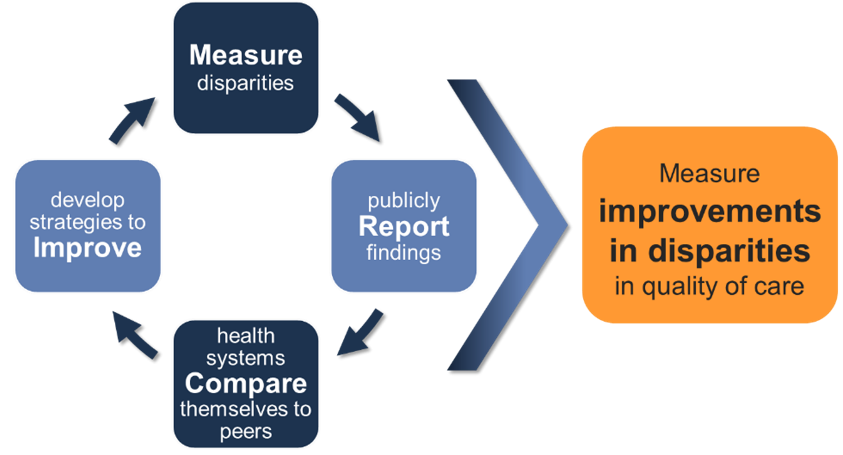- Cancer
- Children and Young Adults
- Chronic Conditions
- Datasets and Research Tools
- Disparities
- Dissemination and Implementation
- HIP Data
- HIPxChange
- Health Equity
- Mental Health
- Older Adults
- Prevention
- Public Reporting
- Quality and Safety
Lead Investigator
Resources
For more information, please contact Dr. Maureen Smith at maureensmith@wisc.edu
In the News
- Racial disparities found among Wisconsin patients in medical systems report
- Fresh data documents the impact that race and income have on health of Wisconsin residents
- Health disparities study shows health gaps in Wisconsin
Other
- 2019 Wisconsin Health Disparities Report
- 2019 Wisconsin Health Disparities Report Infographic
- 2019 Wisconsin Health Disparities Report Appendix
- 2020 Wisconsin Health Disparities Report: Rural and Urban Populations
- 2020 Wisconsin Health Disparities Report Infographic
- 2020 Wisconsin Health Disparities Report Appendix
Areas of Impact
Overview
To identify and reduce disparities in healthcare quality, we are partnering with the Wisconsin Collaborative for Healthcare Quality (WCHQ) and the Collaborative Center for Health Equity to measure and publicly report on disparities in the quality of healthcare in Wisconsin. On September 19, 2019, the 2019 Wisconsin Health Disparities Report was released. This report was developed by WCHQ in collaboration with the University of Wisconsin Health Innovation Program to identify where disparities in health outcomes and care exist in Wisconsin and to help inform and accelerate programs that are working to eliminate disparities.
The Clinical Problem
Although Wisconsin ranks high in overall quality of health care nationally, the state performs poorly with respect to disparities in quality of care—measuring worse than the U.S. average on most reported metrics. These gaps in quality contribute to poor health outcomes for underserved populations, such as people with lower income and less education, racial and ethnic minorities, people with disabilities and residents of urban and rural areas.
Our Response
Public reporting of health system performance
 Through public reporting of health care quality measures, our project aims to improve patient care and outcomes by motivating poorly performing health systems to increase their focus on quality improvement as it relates to health disparities—an approach that has been successful in Minnesota.
Through public reporting of health care quality measures, our project aims to improve patient care and outcomes by motivating poorly performing health systems to increase their focus on quality improvement as it relates to health disparities—an approach that has been successful in Minnesota.
We expect public reporting of disparities to create a positive feedback loop within the state whereby: disparities are measured; results are reported publicly; health systems compare themselves to peers; and poorly performing systems are motivated to undertake improvement activities to address disparities.
To develop a publicly reported measure of disparity, existing quality of care measures, such as blood pressure control, will be stratified by race/ethnicity, payer, and/or rural/urban residence. For example, performance results representing a health system’s achievement of blood pressure control for patients with hypertension will be stratified and presented separately by a disparities indicator such as race/ethnicity. The stratification of the measures by disparity indicators will help inform and accelerate programs that are working to eliminate disparities.
WCHQ members will publicly report performance results by race/ethnicity, payer, or rural/urban residence for at least one publicly reported measure by fall 2021. To view current public performance reports visit: http://reports.wchq.org/
Development of a statewide health disparities report
In September 2019, WCHQ and HIP released the 2019 Wisconsin Health Disparities Report. To produce this report, WCHQ member submitted standardized and recent (2018) clinical data to provide a statewide snapshot that identified disparities by race/ethnicity, payer, and rural/urban residence across health outcomes and care measures. The goal of the report was to provide baseline information on disparities in health outcomes and care within Wisconsin.
“This data provides a next level of detail of where disparities exist. There’s an enormous opportunity now for multiple stakeholders that care about this issue to come together and really dive into the detail to understand where the opportunities are to really bring communities and health systems together” — Dr. Maureen Smith
Results from statewide health disparities report
Health outcome and care measures that have substantial disparities in Wisconsin are presented in the report by race and ethnicity (see below) and by payer (see below). We did not find substantial disparities in health outcome and care measures by rural and urban residence. This is likely due to the categorization of rural and urban that was used for the report. A public report identifying disparities in health outcomes and care applying a nuanced rural and urban residence categorization was released in 2020.
| Race/Ethnicity | Substantial Disparities in Wisconsin Compared to Population Group with the Highest Rate |
| American Indian/Alaska Native | Childhood vaccinations; breast cancer screening; recommended weight; tobacco-free (diabetes; heart disease) |
| Asian/Pacific Islander | Breast cancer screening; colorectal cancer screening |
| Black | Childhood vaccinations; recommended weight; blood pressure control; tobacco-free (diabetes; heart disease) |
| Hispanic/Latino | Recommended weight; blood sugar control (diabetes) |
| White | HPV vaccination; recommended weight |
| Payer | Substantial Disparities in Wisconsin Compared to Population Group with the Highest Rate |
| Commercial | Recommended weight |
| Medicare | Cervical cancer screening* |
| Medicaid | Childhood vaccinations; breast and colorectal cancer screening; depression screening; recommended weight; blood pressure control; blood sugar control (diabetes); tobacco-free (diabetes; heart disease) |
| Uninsured | Childhood vaccinations; HPV vaccination; breast, colorectal, and cervical cancer screening; depression screening; recommended weight; blood sugar control (diabetes) |
*to see full results view the report here
Collaborative effort
Funded by the Wisconsin Partnership Program, this project is a joint effort of the Wisconsin Collaborative for Healthcare Quality (WCHQ), a nationally recognized collaborative to improve health care quality through public reporting of quality metrics for Wisconsin health systems, the Health Innovation Program (HIP) and the Collaborative Center for Health Equity (CCHE). WCHQ includes 38 health care organizations–including 22 large health systems—and represents 65 percent of Wisconsin primary care physicians and 60 percent of all Wisconsin physicians.
Lasting Impact
This project will directly benefit Wisconsin’s most disadvantaged citizens by raising the visibility of gaps in health care quality and creating a long-term and sustainable strategy through public reporting to promote health care improvement and public accountability.
The 2019 Wisconsin Health Disparities Report was the first step in identifying were substantial disparities in health outcomes and care exist in Wisconsin. The report was disseminated to 26 health systems, 111 health departments, and 61 organizations and groups engaged in health equity work throughout the state. The results of the report were presented at the WCHQ Statewide Assembly which was attended by 226 stakeholders from across the state.
The elimination of health disparities cannot be done by health systems alone or accomplished in silos. This results of this project will contribute to the identification of opportunities for health systems, health departments, policymakers, nonprofits and employers to develop collaborative approaches within their communities to create a healthier Wisconsin for all.
Next Steps
The 2020 Wisconsin Health Disparities Report: Rural and Urban Populations was released at the Wisconsin Collaborative for Healthcare Quality (WCHQ) Disparities Assembly in November 2020. The report was developed by WCHQ in collaboration with the Health Innovation Program and presents differences in health outcomes and care for rural and urban populations across Wisconsin. If you have questions, please contact us!
Stratified results for all WCHQ measures are available in a separate appendix document located on HIPxChange: https://www.hipxchange.org/WCHQDisparities. Rural and urban groupings for all ZIP codes in Wisconsin are also available on HIPxChange within the ZIP Codes by Rural and Urban Groupings toolkit.

